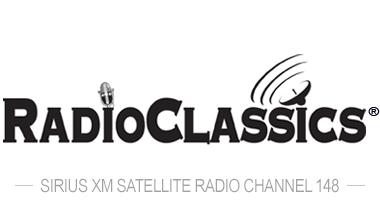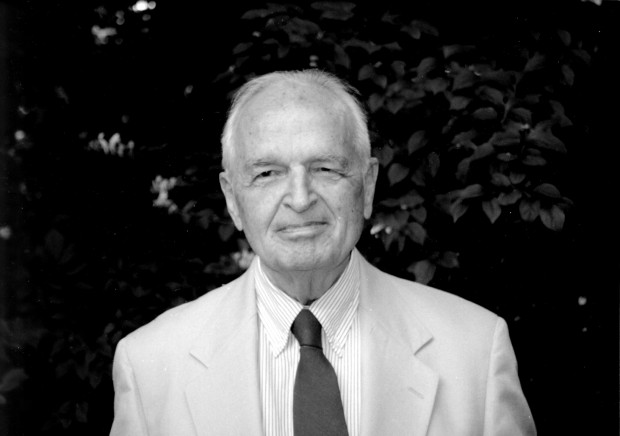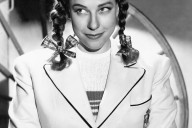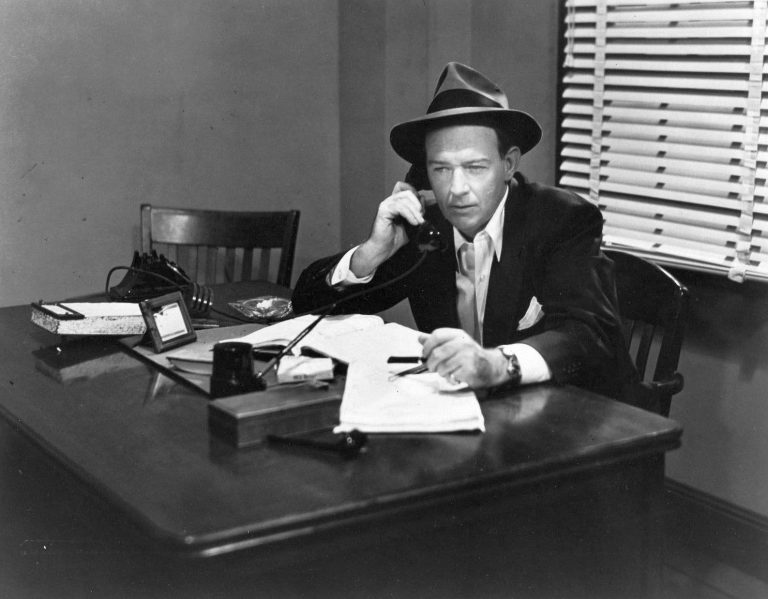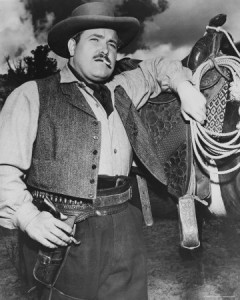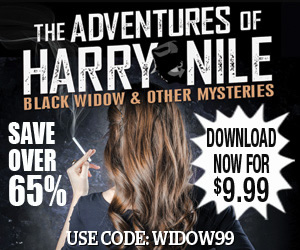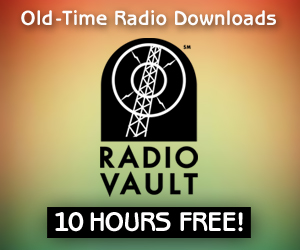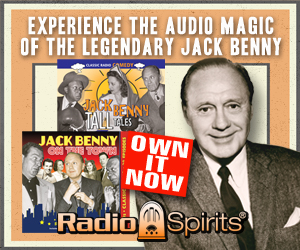by Elizabeth McLeod
Somewhere, someplace there might be some piece of classic crime fiction dealing with shoplifting, or pickpocketing, or tax evasion, or parking in a loading zone. It might take you a long time to find it, but it’s probably out there somewhere. Most authors have long since learned a simple truth: if you want to hold your audience, if you want to give your detective a real challenge. If you want a tale that’s truly gripping, there’s only one crime that works. You’ve got to have a murder. And, no radio series ever presented murder with greater panache than Murder By Experts.
Postwar radio was thoroughly saturated with crime drama, a dramatic format that was inexpensive to produce, required few big-name stars, and could easily be written to a formula. But, the best authors and producers of radio crime fiction understood that quality wasn’t merely a matter of turning out a new script on time (and under budget) every week — there had to be a distinctive edge to the program to make it stand out from the flood of competitors. Other programs did this by making the eccentricities of the star detective a focal point of each week’s episode, but Murder By Experts took the audacious step of making the crime itself the star. Throttlings, poisonings, drownings, stabbings, and shootings — no matter what the method, someone was going to die, and the how was as much a part of the story as the who. And, all of it was presented with the flair and sense of style you’d expect from program creators Robert Arthur and David Kogan.
Dave Kogan spent his entire radio career focusing on the dark side of human nature. He was a member of the first generation of Americans to grow up with radio, becoming an avid fan of the first wave of crime and mystery thrillers to hit the networks in the early 1930’s. These whetted his creative appetite, and he developed an interest in creating such dramas himself — a path which led him to a radio writing class at Columbia University. It was there that, in 1940, he struck up a friendship with fellow student Robert A. Arthur Jr.
Arthur was a well-traveled man in his early thirties when he met Dave Kogan — born in the Philippines to an Army family, he was a University of Michigan graduate with a masters in journalism and an impressive track record in the pulp magazines. Name a famous detective pulp of the thirties, and Bob Arthur wrote for it. He was a restless, inquisitive man with a near-compulsive need to tell stories, and radio offered him yet another outlet. He and Kogan hit it off immediately and began working up script ideas. Their first successful collaboration was a short-lived thriller anthology for producer Jack Johnstone at WOR called Dark Destiny. Running just over six months, this early venture set the pattern and work routine that the rest of their partnership would follow — joint plotting sessions, one or the other of the partners forming the general concepts into a working script, and then Kogan taking over the director’s role in assembling the actual broadcast.
By the spring of 1943, as Dark Destiny came to an end, Kogan and Arthur were firmly ensconced at WOR, working most often with the prolific producer Jock MacGregor, and contributing scripts to most of the Mutual network’s thriller series. Their defining program, The Mysterious Traveler, took shape during this period and proved their most enduring success — helping to solidify the “horror host” formula that became the definitive format for supernatural drama on the air. Ghost stories, science fiction, gothic horror…all rode the Traveler’s train. Kogan and Arthur were building a strong following among those with a taste for the spine-tingling.
Murder By Experts came along in 1949, as The Mysterious Traveler was at its peak of popularity, and offered its audience a considerably more rigorous format than its predecessor. Whereas anything could happen in the Traveler’s stories, Murder By Experts chose to specialize. Murder was the focus, and there wouldn’t be any whispered voices in the night, spooky doings in graveyards, or unexplainable phenomena. These were to be detective stories, but detective stories told in the classical style. None of the Chandleresque cynical gumshoe approach here, no wisecracking private dicks and sultry secretaries, no metaphor-twisting first-person-singular narration. There was a crime, and a solution to that crime. The story was in the crime itself, and in the path the detective followed to solving it. The main conceit would be that each week’s story would be selected by an ”expert” in the murderous art — usually a noted detective story author. In truth, Kogan and Arthur had merely made an arrangement with the Mystery Writers of America to use the names of its members in endorsing the stories, but the authors themselves had little if any say in choosing the scripts. Kogan and Arthur, aided by such freelancers as Milton Lewis, Harold Swanton, and Joseph Ruscoll, turned out the dramas while adhering as closely as possible to the traditions of the genre.
Kogan and Arthur selected an ideal host to front the new series. John Dickson Carr was one of the top practitioners of the art of literary homicide — one of the most refined practitioners of the classical “murder in a locked room” story, in which a refined, intelligent detective used coolly intellectual methods to pick out the killer from a long list of suspects. His own stories had regularly been featured on Suspense and other top American anthologies for years, while the author himself resided in England. His attachment to Murder By Experts shortly after he returned to the states in 1948 immediately gave the new series credibility and guaranteed a loyal audience even before its first broadcast (even though Carr himself did not contribute to the scripts).
The acting talent on the program drew from the deep pool of performers familiar to listeners of New York-based radio drama — such stalwarts as Lawson Zerbe, Larry Haines, Ann Shepherd, Roger de Koven, Hester Sondergaard, and Santos Ortega were frequent members of the Murder by Experts cast. Even Maurice Tarplin, the Mysterious Traveler himself, picked up an occasional role on the program. Most scripts were new to radio, but occasionally Kogan and Arthur would dust off an old chestnut like “The Creeper” or “Return Trip” and give it a fresh staging, fitting easily into the Murder By Experts format. Before the end of its first year, the program was acknowledged as tops in its field by the Mystery Writers of America — receiving the Edgar Allan Poe award for 1949 as the best radio thriller on the air.
Despite the plaudits, however, Murder By Experts, like most Mutual dramas, never attracted the attention of a sponsor, and never received the infusion of cash that might have encouraged Kogan and Arthur to expand even further on the format. John Dickson Carr left the series in mid-1950, and was replaced by Brett Halliday — the pseudonymous creator of detective Michael Shayne. In real life the prolific writer Davis Dresser, “Halliday” was a founding member of the Mystery Writers of America. As such, he edited a print anthology of stories from the series published in 1951, just as the program itself was coming to an end.
Some consider Murder By Experts yet another casualty of the political purges of the McCarthy era. In fact, Arthur and Kogan were both targeted for their activism in connection with the Radio Writers Guild, a labor union attacked by witch-hunters during the early fifties. But, neither Kogan nor Arthur were listed in the red-baiters’ bible “Red Channels,” and it wasn’t until well into 1952 that their names came up among many others before the House Un-American Activities Committee. By then, Murder By Experts was already dormant, a casualty as much of budgetary issues and internal strife at Mutual as of the unfortunate political zeitgeist of the time. Whatever the circumstances of its end, Murder By Experts left behind a legacy of outstanding detective drama — crimes of passion solved first and foremost by the intellect.
Copyright 2013 Elizabeth McLeod and RSPT LLC. All rights reserved.
